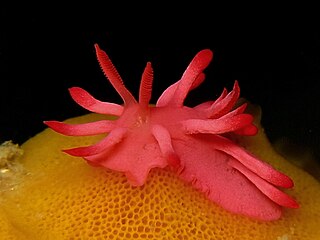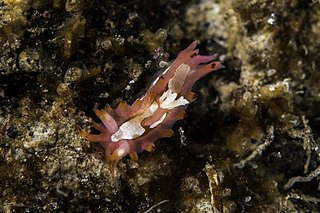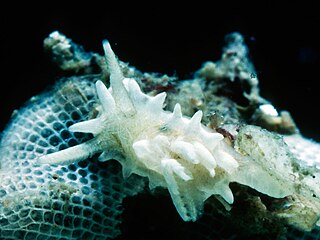
Okenia is a genus of colorful sea slugs, specifically of dorid nudibranchs, marine gastropod mollusks in the family Goniodorididae.
William B. "Bill" Rudman is a malacologist from New Zealand and Australia. In particular he studies sea slugs, opisthobranch gastropod molluscs, and has named many species of nudibranchs.

Okenia rosacea, commonly known as Hopkin's rose nudibranch, is a species of sea slug, specifically a dorid nudibranch, a marine gastropod mollusc in the family Goniodorididae.
Okenia hallucigenia is a species of sea slug, specifically a dorid nudibranch, a marine gastropod mollusc in the family Goniodorididae.
Okenia stellata is a species of sea slug, specifically a dorid nudibranch, a marine gastropod mollusc in the family Goniodorididae.
Okenia vena is a species of sea slug, specifically a dorid nudibranch, a marine gastropod mollusc in the family Goniodorididae.

Okenia angelensis common name Los Angeles Okenia, is a species of sea slug, specifically a dorid nudibranch, a marine gastropod mollusc in the family Goniodorididae.
Okenia mija is a species of sea slug, specifically a dorid nudibranch, a marine gastropod mollusc in the family Goniodorididae.

Okenia distincta is a species of sea slug, specifically a dorid nudibranch, a marine gastropod mollusc in the family Goniodorididae.

Okenia barnardi is a species of sea slug, specifically a dorid nudibranch, a marine gastropod mollusc in the family Goniodorididae.

Okenia liklik is a species of sea slug, specifically a dorid nudibranch, a marine gastropod mollusc in the family Goniodorididae.

Okenia echinata is a species of sea slug, specifically a dorid nudibranch, a marine gastropod mollusc in the family Goniodorididae.
Okenia eolida is a species of sea slug, specifically a dorid nudibranch, a marine gastropod mollusc in the family Goniodorididae.
Okenia impexa is a species of sea slug, specifically a dorid nudibranch, a marine gastropod mollusc in the family Goniodorididae.

Okenia japonica is a species of sea slug, specifically a dorid nudibranch, a marine gastropod mollusc in the family Goniodorididae.
Okenia kondoi is a species of sea slug, specifically a dorid nudibranch, a marine gastropod mollusc in the family Goniodorididae. It is the type species of the genus Sakishimaia.
Okenia nakamotoensis is a species of sea slug, specifically a dorid nudibranch, a marine gastropod mollusc in the family Goniodorididae.
Okenia purpurata is a species of sea slug, specifically a dorid nudibranch, a marine gastropod mollusc in the family Goniodorididae.
Okenia vancouverensis is a species of sea slug, specifically a dorid nudibranch, a marine gastropod mollusc in the family Goniodorididae.

Jorunna parva, commonly known as the sea bunny, is a species of dorid nudibranch, a shell-less marine gastropod mollusc in the family Discodorididae. The species was first described by Kikutaro Baba. Its resemblance to a rabbit facilitated a surge in popularity on Twitter throughout Japan in 2015.








